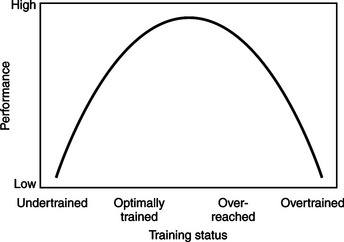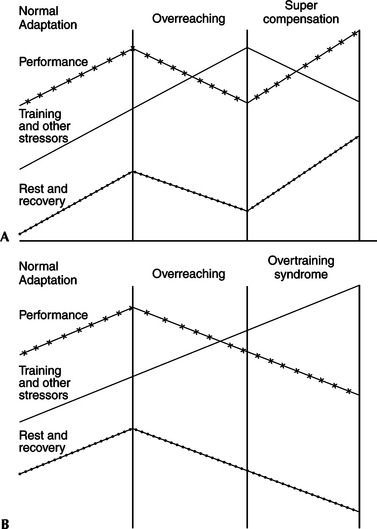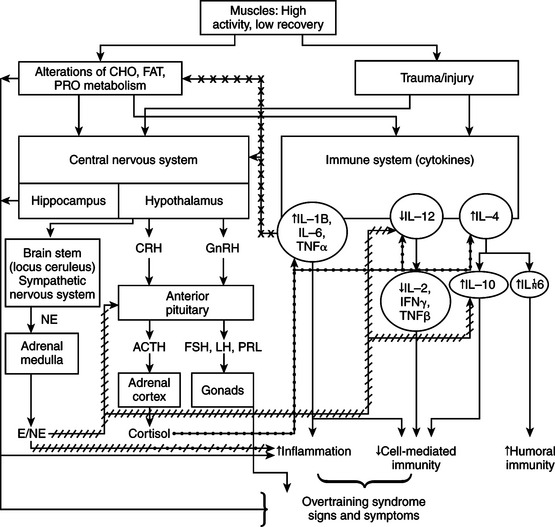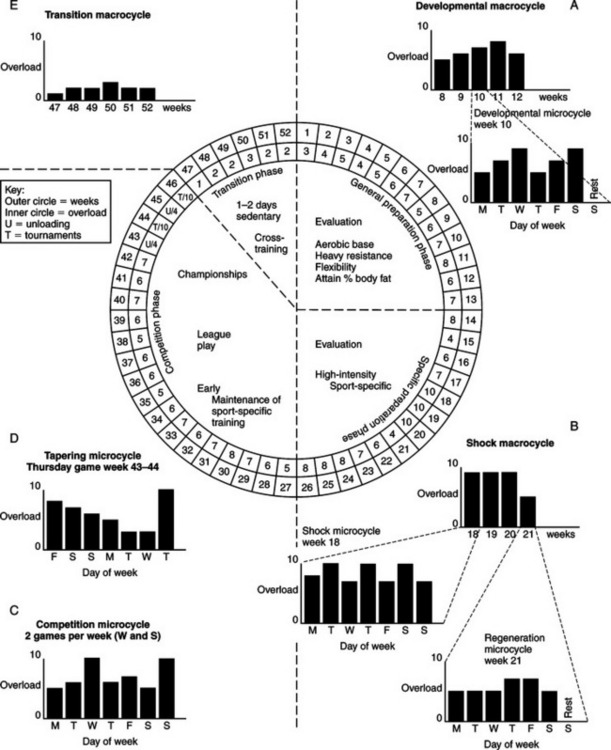Chapter 7 Physiological Effects of Overtraining and Detraining*
After studying this chapter, the reader will be able to do the following:
EXERCISE TRAINING
Training Principles
Periodization
Figure 7-1 is an example of how periodization might be arranged for a basketball player whose season lasts approximately 4.5 months. This is intended as an example only because periodization depends on individual situations and abilities. In Figure 7-1, the time frame of 1 year—presented as 52 weeks (outer circle) —has been divided into four phases or cycles: the general preparatory (sometimes labeled off-season) phase, the specific preparatory (also known as preseason) phase; the competitive (or in-season) phase; and the transition (active rest) phase.1–3 Each phase is typically divided into macrocycles that may vary in length from 2 to 6 weeks. A macrocycle is further divided into microcycles lasting 1 week.4,5 Each type of cycle aims for an optimal mixture of work and rest. Macrocycles and microcycles have five basic goals or patterns: (1) developmental; (2) shock; (3) competitive, or maintenance; (4) tapering, or unloading; and (5) transition, or regeneration.1
In Figure 7-1 the first macrocycle (Figure 7-1, A) represents a developmental cycle for the preparatory stage and is designed to improve either general or specific fitness attributes, such as an aerobic base or sport-specific strength, progressively. Overloading is achieved by a stepwise progression from low to medium to high by gradually increasing the load for three cycles, followed by a regeneration cycle back to the level of the second load. This second load level then becomes the base for the next loading cycle. This is what is meant by steploading.
Shock cycles, illustrated in Figure 7-1, B, are used primarily during the preparatory phase and are designed to increase training demands suddenly. They should always be followed by a regeneration cycle that consists of a drastically reduced training load.
Competitive cycles (Figure 7-1, C) are based on maintaining physiological fitness while optimizing performance on game days. Obviously, competitive macrocycles and microcycles occur during the competitive phase.
Tapering or unloading regeneration cycles (Figure 7-1, D) involve systematic decreases in overload to facilitate a physiological fitness peak.1 As noted, regeneration cycles are used both as breaks between other cycles and to form the basis of the active transition phase (Figure 7-1, E).1,2,5 They are intended to remove fatigue, emphasize relaxation, and prevent overtraining.
Microcycles are further subdivided into daily workouts or lesson plans. Depending on the maturity and experience of the athlete and the level of competition, a training day may entail one, two, or three workouts.1
The general preparatory, or off-season, phase should be preceded by a sport-specific fitness evaluation to guide both the general and specific preparatory training programs. Another evaluation might be conducted before the season if desired, or evaluations might be conducted systematically throughout the year to determine how the individual is responding to training and to make any necessary adjustments. All evaluation testing should be done at the end of a regeneration cycle so that fatigue is not a confounding factor. The off-season is a time of general preparation when basic fitness components are emphasized to develop cardiovascular-respiratory endurance (an aerobic base), flexibility, and muscular strength and endurance. Any needed changes in body composition should be addressed during this phase.5 An aerobic base is important for all athletes, even those whose event is primarily anaerobic. A high aerobic capacity allows the individual to work at a higher intensity before accumulating large quantities of lactic acid and becoming fatigued. A high aerobic capacity also allows the individual to recover faster, which is important both in and of itself and for allowing for a potentially greater total volume of work during interval sessions.1
During this general preparatory phase, overload progresses by steps in both intensity and volume (frequency times duration) with volume typically being relatively more important than intensity.1 During the preseason phase, the athlete shifts to specific preparation for the fitness and physiological components needed to succeed in the intended sport. The training program at this time is heavy and generally occupies the 7 to 8 weeks before the first competition. About midway through the specific preparatory phase, intensity may surpass volume in importance. This will vary with the physiological demands of particular sports.5
Once the athlete begins the competition phase, the emphasis shifts to maintaining the sport-specific fitness that was developed during the preseason. Although both volume and intensity may be maintained, heavy workouts should immediately follow a competition instead of directly preceding one. During the late season, when the most important competitions are usually held (such as conference championships or bowl games), the athlete should do only a minimum of training or taper gradually by decreasing training volume but maintaining intensity so that he or she is rested without being detrained. For particularly important contests, both training volume and intensity might be decreased to peak for a maximal effort.5
The transition phase begins immediately after the last competition of the year. The athlete should take a couple of days of complete rest and then participate in active rest using noncompetitive physical activities that are not his or her primary sport. This type of activity is often called cross-training. In this transition phase, neither training volume nor intensity should exceed low levels.5
TRAINING ADAPTATION AND MALADAPTATION
Training and its relationship to athletic performance exist on a continuum that is best described as an inverted U (Figure 7-2).6–8 At one end of the continuum are individuals who are undertrained and whose fitness level and performance abilities are dictated by genetics, diseases, and nonexercise lifestyle choices. Individuals whose training programs lack sufficient volume, intensity, or progression for either improvement or maintenance of fitness or performance are undertrained. The goal of optimal periodized training is the attainment of peak fitness or performance, or both. However, if the training overload is too much or improperly applied, then maladaptation is possible. The first step toward maladaptation may be overreaching (OR), a short-term decrement in performance capacity that is easily recovered from and generally lasts only a few days to 2 weeks. OR may develop into overtraining.

Figure 7-2 Training and performance.
(From Plowman SA, Smith DL: Exercise physiology for health, fitness, and performance, ed 2, San Francisco, 2003, Benjamin Cummings.)
OR can result from either planned shock microcycles, as previously described, or, inadvertently, from too much stress and too little planned recovery.6,7,9 If OR is planned and recovery is sufficient, positive adaptation and improved performance, sometimes called supercompensation, result (Figure 7-3, A). If, however, OR is left unchecked or the individual or coach interprets the decrement in performance as an indication that more work must be done, OR may develop into overtraining (Figure 7-3, B). Overtraining, more properly called the overtraining syndrome (OTS) (or staleness) is a state of chronic decrement in performance and ability to train, in which restoration may take several weeks, months, or even years.7,9–11 Because the only universally apparent result of the OTS is a decrement in performance, the term unexplained underperformance syndrome (UPS) has been suggested.12 Acceptance of this terminology has been slow.

Figure 7-3 Exercise training adaptation (A) and maladaptation (B).
(From Fry RW, Morton AR, Keast D: Can J Sport Sci 17:241-248, 1992; Kuipers H: Med Sci Sports Exerc 30: 1137-1139, 1998; Kreider RB, Fry AC, O-Toole ML: Overtraining in sport, pp. vii-ix, Champaign, III, 1998, Human Kinetics; Halson SL, Jeukendrup AE: Br J Sports Med 32: 107-110, 1998.)
The relationship between OR and OTS is often depicted as a continuum.6 That is, as the imbalance between training and recovery increases, the complexity of the symptoms also increases and the athlete progresses from OT to OTS. However, research data to back this up do not exist.13 Coaches and athletes often use shock microcycles to induce OR in the normal periodization of training. Therefore it is possible for scientists to follow and test athletes in such a situation. However, it is neither ethical nor reasonable to deliberately induce a state of OTS. Thus scientific data on the OTS has largely been derived retrospectively from case studies of athletes with unexplained underperformance. Data in which meaningful numbers of subjects in both resistance and endurance activities have been followed from adaptation and performance improvement through overreaching to the overtraining syndrome simply do not exist.
What does exist is a long list of signs and symptoms that have been observed in athletes exhibiting unexplained performance decrements.6,14 A sampling of some that may be observed by the athlete himself or herself, the coach, or athletic trainer is presented in Table 7-1.
Table 7-1 Signs and Symptoms of the Overtraining Syndrome
| Type | Signs and Symptoms |
|---|---|
| Performance-related | Consistent decrement in performance |
| Persistent fatigue and sluggishness that leads to several days of poor training | |
| Prolonged recovery from training sessions or competitive events | |
| Reappearance of already corrected errors | |
| Increased occurrence of muscular accidents/injuries | |
| Physiological | Decreased maximal work capacities and markers |
| Increased disruption of homeostasis at submaximal workloads | |
| Headaches or stomachaches out of proportion to life events | |
| Insomnia | |
| Persistent low-grade stiffness and soreness of the muscles and joints; feeling of “heavy” legs | |
| Frequent upper respiratory tract infections: sore throats, colds, or cold sores | |
| Constipation or diarrhea | |
| Loss of appetite; loss of body weight or muscle mass, or both, when no conscious attempt is being made to diet | |
| or when weight loss is undesirable | |
| An elevation of approximately 10% in the morning heart rate taken immediately on awakening | |
| Amenorrhea | |
| Psychological/Behavioral | Feelings of depression |
| General apathy, especially toward previously enjoyed activities | |
| Decreased self-esteem | |
| Emotional instability or mood changes | |
| Difficulty concentrating | |
| Loss of competitive drive or desire | |
| Perceived insufficient recovery |
From Plowman SA, Smith DL: Exercise physiology for health, fitness, and performance, ed 2, San Francisco, 2003, Benjamin Cummings.
Intentionally incomplete, this list is further complicated by the fact that two forms of the OTS probably exist: a sympathetic form and a parasympathetic form.9,15–21 The sympathetic form is characterized by an increased sympathetic neural tone at rest and during exercise and down-regulation of beta (β) receptors. Restlessness and hyperexcitability dominate. For example, an elevated resting heart rate, slower heart rate recovery postexercise, decreased appetite and unintentional loss of body mass, excessive sweating, and disturbed sleep patterns are symptomatic of the sympathetic form of overtraining.6,19 The sympathetic form of overtraining is generally considered to be an early indication of overtraining. It appears to be most closely related to high-intensity anaerobic activities.9 The parasympathetic form of overtraining is characterized by sympathetic neural insufficiency, a decreased sensitivity to the pituitary and adrenal hormones, and an increase in parasympathetic tone at rest and during exercise. The symptoms of the parasympathetic form of overtraining are less obvious and in isolation may be difficult to distinguish from positive training adaptations.6,19 For example, resting pulse rates may be lower, submaximal exercise heart rates and lactate responses lower, and heart rate recovery from exercise rapid; however, these responses are typically associated with early fatigue and impaired maximal work capacity markers, such as heart rate and lactate. Apathy, digestive disturbances, and altered immune and reproductive function are common. The parasympathetic form of the overtraining syndrome is the more advanced form. It appears to be most frequently associated with excessive volume training in both aerobic endurance activity and dynamic resistance exercise.9 Individual differences in the nervous system may predispose any given individual to either up-regulation (sympathetic form) or down-regulation (parasympathetic form) of the neuroendocrine homeostasis.
Hypothesized Causes and Mechanisms of Overtraining Syndrome
The precise cause(s) and mechanism(s) of OTS are unknown. A high-volume training load performed at high intensity and applied in a monotonous manner without sufficient rest and recovery, which alters metabolic processes and leads to an accumulation of muscle trauma, appears to be the primary predisposing factor (Figure 7-4).6,10,12,22–24 Related stressors, such as frequent competition, excessive travel, training and competing under inhospitable environmental conditions, and poor nutrition, as well as unrelated stressors, such as family, school, or work commitments, accumulate and are likely peripheral causes. In this context a stressor is defined as any activity, event, or impingement that causes stress, and stress is defined as any disruption in body homeostasis and all attempts by the body to regain homeostasis.25 Both acute exercise and chronic training are stressors.

Figure 7-4 Hypothesized mechanism of the overtraining syndrome.
(From Fry RW, Morton AR, Keast D: Can J Sport Sci 17:241-248, 1992; Kreider RB, Fry AC, O’Toole ML: Overtraining in sports, pp. vii-ix, Champaign, Ill, 1998, Human Kinetics; Budgett R: Br J Sports Med 32:107-110, 1998; Petibois C, Cazorla G, Poortmans J-R, et al: Sports Med 32:867-878, 2002; Petibois C, Cazorla G, Poortmans J-R, et al: Sports Med 33: 83-94, 2003; Smith LL: Med Sci Sports Exerc 32:317-331. 2000; Snyder AC: Med Sci Sports Exerc 30:1146-1150, 1998; Steinacker JM, Lormes W, Reissnecker S, et al: Eur J Appl Physiol 91:382-391, 2004; Gastmann UAL, Lehmann MJ: Med Sci Sports Exerc 30: 1173-1178; Robson PH: Sports Med 33-771-781, 2003; Chrousos GP, Gold PW: JAMA 267: 1244-1252, 1992; Smith LL: Sports Med 33:347-364, 2003; Moldoveanu AL, Shephard RJ, Shek PN: Sports Med 31:115-144, 2001; Keizer HA: Neuroendocrine aspects of overtraining. In Kreider RB, Fry AC, O’Toole ML, editors: Overtraining in sports, pp. 145–167, Champaign, Ill, 1998, Human Kinetics.)
Attempts at explaining the physiological mechanisms by which the probable causative factors actually bring about the OTS have resulted in a number of hypotheses. It is important to remember that a hypothesis by definition is “an assumption not proved by experiment or observation. It is assumed for the sake of testing its soundness or to facilitate investigation of a class of phenomena.”26 Thus although research data may account for some observed symptoms of the OTS, they are generally insufficient to even support the use of the term theory. In short, the underlying mechanism(s) remain(s) unproven at this point.10
In general the hypotheses may be categorized into three major areas: biochemical/metabolic, neuroendocrine, and immunological. Figure 7-4 indicates how all of these areas may interact in producing the OTS.
Stay updated, free articles. Join our Telegram channel

Full access? Get Clinical Tree









